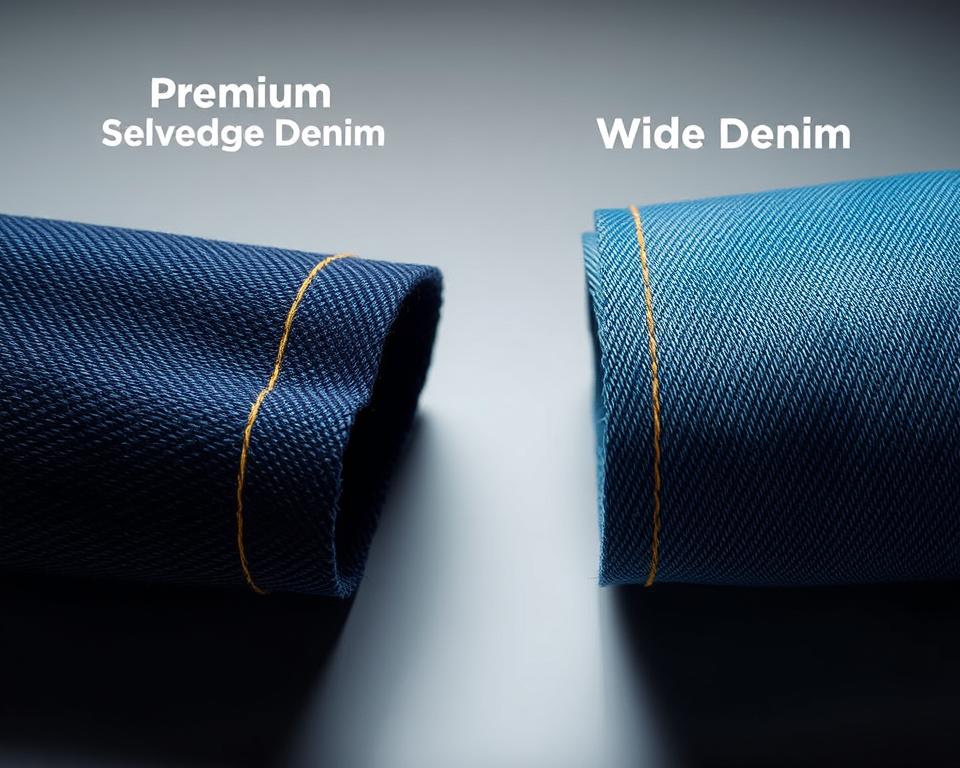The Ultimate Manual to Superior denim Edge-to-Edge Textile
Have you ever questioned the reason some jeans feel like they’re made to last a lifetime? The secret lies in the elements and artistry. Take, for instance, the growing movement of superior selvedge. This goes beyond common fabric—it’s a testament to quality and tradition.
Today, a growing number of people are opting for these everlasting fabrics for their durability and iconic selvedge denim by the yard allure. Be it that you are a do-it-yourself sewist or a denim enthusiast, there’s an exceptional aspect about employing superior cotton and thread. It’s not just about constructing pants; it involves fashioning something that tells a story.
Here at Core Fabrics, we’ve selected a collection of 14.25oz organic cotton and stretch choices. These fabrics are tailor-made for everything from raw trousers to high-fashion jacket patterns. Prepared to dive into the realm of top-tier fabrics? Let’s jump right in.
What Is Denim Selvedge Fabric?
What is it that makes particular jeans distinguish themselves with their unique, self-finished edges? The answer lies in the selvedge denim, a superior fabric known for its durability and retro appeal. In contrast to conventional textiles, this type of fabric is fashioned with traditional methods that have proven their worth.
Understanding Selvedge Denim
Selvedge denim is manufactured via old-style shuttle looms, which produce minimal widths of about 30-35 inches. These looms weave the material in a method that delivers self-finished borders, often marked by a distinctive red line. This method confirms the material is densely interlaced and extremely robust.
Contemporary looms, in contrast, produce expansive fabric but lack the same level of artistry. Minor flaws in selvedge, like twists in the leg or inconsistent patterns, are accepted as elements of its beauty. This approach, termed “wabi-sabi”, honors the beauty of inherent flaws.
The Making of Selvedge Denim
The production of selvedge denim requires a exacting process. Shuttle looms interlace the filling yarns back and forth, resulting in a dense and resilient material. This method contrasts with new-age looms, which prioritize speed and efficiency over durability.
Labels such as Karson Denim uphold vintage Japanese craft practices from the nineteen-nineties. They intentionally include anomalies to retain the authenticity of the material. Every item is graded on a 4-point system, confirming it meets the top criteria of excellence.
| Feature | Selvedge Denim | Contemporary Denim |
|---|---|---|
| Width | 30-35 inches | 60+ inches |
| Fabrication Method | Classic Shuttle Loom | New-Age Loom |
| Texture | Non-uniform, Raw | Uniform |
| Durability | High | Standard |
“The charm of selvedge lies in its imperfections—every imperfection narrates a tale artistry and heritage.”
The History of Selvedge Denim
From humble beginnings to worldwide renown, the story of these textiles is multifaceted and motivational. Initially designed as rugged attire in seventeenth-century France evolved into a signifier of timeless style and craftsmanship.
Origins in Traditional Weaving
The origin of this material trace back to Nîmes, France, where it was known as “serge de Nîmes.” First intended for laborers, it was crafted out of robust cotton and stitching. Its resilience made it a favorite among workers during the era of the Gold Rush.
In the 20th century, it had transformed into a staple for pants. The closure of the Cone Mills White Oak plant served as a catalyst. This transition opened the door for Japanese craftsmen to revive classic fabric-making practices.

Advancements in Production
Post-WWII, Japan embraced old-school American culture. Skilled workers revitalized classic looms to manufacture authentic reproductions. This devotion to quality secured the continuance of selvedge as a specialty product.
In modern times, breakthroughs from Italy and Turkey have brought forth environmentally conscious combinations and elastic selections. These modernizations have enhanced the attraction of this classic textile. Within Core Fabrics, we procure internationally, from Montréal to Asia, to bring you the finest quality.
“The history of selvedge is a celebration of the enduring value of craftsmanship and legacy.”
The Benefits of Selvedge Denim?
Why does selvedge denim shine in the universe of superior materials? Its special characteristics and incomparable robustness have made it beloved among lovers and stylists alike. Whether you’re making jeans or a structured jacket, this fabric offers a fusion of classic methods and updated style.
Characteristic Features of Selvedge
Selvedge denim is known for its firm interlacing, which enhances durability and wear patterns. Differing from regular textiles, denim selvedge fabric is fashioned using time-honored shuttle looms, creating a more compact and exceptionally sturdy material. In doing so, it secures that all products boast a unique texture and personality.
Key features include:
- Textured, firm raw denim contrasts with softened, pre-washed stretch fabrics.
- Through sanforization, sizes become reliable, while untreated fabrics provide a dynamic fitting process.
- Variants include 9.5oz Eco Finish to 14.25oz Organic, suited for diverse applications.
Durability and Longevity
One of the key attributes of selvedge denim is its enduring nature. The dense fabric structure boosts robustness while enabling distinctive color fades over time. This renders it a treasured choice for those looking for enduring style.
Important aspects:
- Fabrics weighing between 12oz and 14oz are perfect for form-fitting jackets and jeans that mellow with time.
- The 14.25oz True Indigo option is highly favored for enduring jeans.
- Eco-friendly options, like recycled cotton and indigo blends, add sustainability to your wardrobe.
At Core Fabrics, our collection includes a variety of options to suit your needs. From raw to sanforized, each piece is crafted to deliver exceptional quality and value.
Selvedge Denim vs. Wide Denim
In the creation of durable and stylish garments, the decision of textile is pivotal. Two popular options are selvedge and wide denim, each with unique characteristics. Comprehending their variances guides the best option for your creation.
Contrasting Weave Techniques
Selvedge denim is produced using classic shuttle looms, producing slim widths of 30-35 inches. This selvedge denim jacket process forms tightly woven edges, often marked by a characteristic red line. In contrast, wide denim is produced using modern projectile looms, yielding spans of 60+ inches.
Shuttle looms are slower, producing about 3 meters per minute, while modern projectile looms reach speeds of 30 meters per minute. This difference in speed impacts both the price and the texture of the final product.
Advantages and Disadvantages
Selvedge denim is celebrated for its superior quality and strength. Its narrow width renders it perfect for projects where defined edges and detail work are sought. However, it can be more expensive, typically around $23 per meter.
Wide denim is more cost-effective, typically costing $8 per half-meter. Its broader span minimizes excess, well-suited to extensive endeavors like upholstery. However, it does not feature the distinctive selvage detail of selvedge.
| Characteristic | Selvedge Denim | Wide Denim |
|---|---|---|
| Measurement | 30-35 inches | 60+ inches |
| Technique | Traditional Shuttle | Contemporary Projectile Loom |
| Rate | 3m/min | 30 meters per minute |
| Expense | $23 per meter | $8/half-meter |
When precise, structured edges are required—as in Grainline Thayer jackets—selvedge wins out. For larger projects, wide denim offers better value and efficiency. Evaluate your project specifications to choose wisely.
How to Use Selvedge Denim
Utilizing superior fabrics can transform your sewing endeavors. Whether you’re crafting jeans, blazers, or dresses, grasping fabric quantities, proper sewing methods, and maintenance guarantees a polished result. Let’s delve into how to make the most of this classic textile.
Material Requirements for Jeans and Jackets
When planning your project, calculating the right amount of material is crucial. Approximately 3-3.3 yards is necessary for men’s jeans, considering defects and shrinkage. Trucker-style jackets generally demand about 3.3 yards, while skirts can be made with just 2 yards.
Smart pattern positioning minimizes the impact of defects. Instead of cutting around defects, consider integrating them into your design for a unique look.
| Item | Yardage Needed |
|---|---|
| Men’s Jeans | 3-3.3 yards |
| Trucker-Style Jacket | 3.3 yards |
| Skirt Item | 2 yards |
Sewing Techniques and Maintenance
Employing proper equipment and methods leads to an impeccable finish. Choose #70-110 needles and machine attachments suitable for thick fabrics. Use Gütermann rPET thread for effective contrast stitching.
Consider these extra tips:
- A tailor’s clapper helps deliver defined creases without unwanted shine.
- Core Fabrics’ denim kits include topstitch thread, rivets, and 9mm jeans buttons for a professional finish.
- For structured edges, like those in jackets, selvedge is the preferred choice.
Correct care ensures your garments last longer. Limit washing and allow to air dry for optimal durability. Adhering to these practices will sustain your creations for years.
In Closing
Using superior fabrics goes beyond mere durability—it’s about instilling personality. Selvedge denim embodies this ideology, merging artisanal charm with robust strength. Be it crafting jeans or tailoring a refined jacket, each stitch narrates a tale.
Core Fabrics simplifies your creative journey. Experience our swatch service to gauge texture and weight prior to purchase. Additionally, benefit from complimentary shipping on orders exceeding $150 USD throughout North America.
Looking ahead, eco-friendly blends and vintage washes are shaping the future of cotton textiles. Such innovations provide novel methods for infusing eco-consciousness and fashion into your closet.
Prepared to immerse yourself in superior fabrics? Begin your journey now and appreciate the merit of intentional crafting. Your future project might just be that lasting masterpiece.

